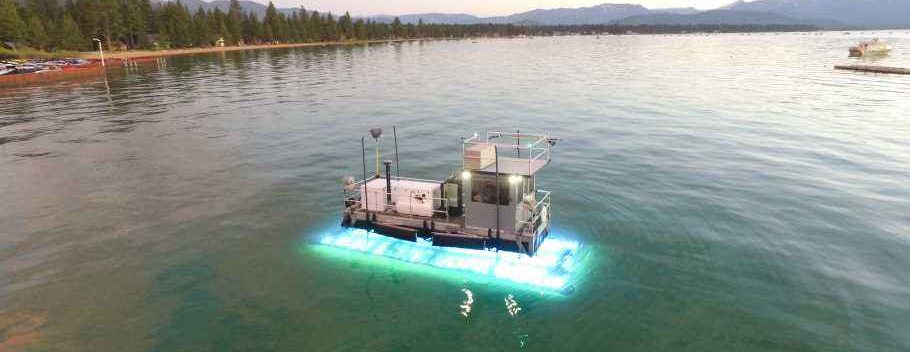
By Joanne S. Marchetta
A return to pre-pandemic normalcy is still a few steps from our reach, but as the vaccine continues to roll out and contagion numbers improve, many of us are looking forward to taking our lives off hold and possibly having a safe summer. Warmer temperatures enliven more than our spirits, however. Aquatic invasive weeds in Lake Tahoe do most of their malignant growth in warmer weather, and this summer will also mark a surge in basin-wide work to knock them back.
The Tahoe Regional Planning Agency (TRPA) and many partners are implementing the multi-agency Aquatic Invasive Species (AIS) action agenda that prioritizes near and long-term control measures to halt the damage being done to Lake Tahoe by invasive plants, warm-water fish, and amphibians. The agenda calls for swift, unprecedented action to achieve a 90 percent or greater reduction in aquatic invasive plants, with a specific focus on the weed-choked lagoons of the Tahoe Keys in South Lake Tahoe. The stress of climate change on the ecosystem is adding to the urgency. In just five decades, Tahoe’s average water temperature has increased 1.4 degrees, which makes it more hospitable for invasive species.
Non-native species were introduced here years before knowledge about invasive species was widespread. These invasives pose a massive threat to Lake Tahoe’s ecosystem and economy. Non-native Eurasian watermilfoil and curlyleaf pondweed that are here now have no competition for light and space in our distinctly clear waters and, until recently, were spreading unchecked. The weeds increase algae growth, provide habitat for other invasive species, and create their own ruinous ecosystem wherever they are allowed to take hold. Aquatic invasive plants can cost millions every year to combat and significantly impact the recreation experience for residents and visitors alike.
A broad coalition has formed around this threat. TRPA has worked with partners to bring approximately $11 million in federal funding to the basin and researchers, non-profits, and property owners are collaborating with public agencies on the action agenda. Together we are driving innovative methods to halt the spread. For more than a decade, small-scale success has come from laying mats over the weeds to starve them of sunlight. Projects to control invasive plants in Crystal Bay and Emerald Bay have proven successful. Priority projects using conventional methods are underway at Elks Point Marina and the Taylor and Tallac Creek marsh, and a new technique is being piloted at Ski Run Marina. However, the largest in-lake control project underway is on a large infestation spreading lakeward from the Tahoe Keys lagoons. For now, maintenance work outside the Keys is needed to keep that population contained while solutions within the Keys are developed.
But time is of the essence and traditional methods may not be enough. The massive, 172-acre infestation within the Tahoe Keys has not come under control despite significant work and investment by the Tahoe Keys Property Owners Association, public agencies, and non-profits. For example, the League to Save Lake Tahoe is helping with innovative equipment to reduce weed fragments from being carried out into the lake.
Keys property owners have applied for a permit to test new methods, including EPA-approved herbicides, to determine what can work across the diverse lagoon environment. TRPA and the Lahontan Regional Water Quality Control Board are finishing technical and environmental review of the permit application this summer and the tests could begin in 2022. Meanwhile, partners will jumpstart testing of ultraviolet light treatments in the Tahoe Keys this summer, more than doubling the size of previous treatments.
As climate change impacts continue to weave their way throughout the Tahoe Basin, we must work together on the highest priority invasive species control projects. Environmental challenges at Tahoe have never been overcome by one group or agency working alone. Major climate adaptations like AIS control will require an epic level of collaboration.
On the same front, we must remain vigilant keeping new invasive species out of Tahoe. Since 2008, the Tahoe watercraft inspection program has prevented new invasive species in the region and the program is looked to nationally as a model. Epic collaboration and the strength of public-private partnerships are the successful foundations of our watercraft inspection program. Moving forward comprehensively on control is the only appropriate complement to our success in prevention if we want to protect the lake for future generations.
–Joanne S. Marchetta is the Executive Director of the Tahoe Regional Planning Agency

